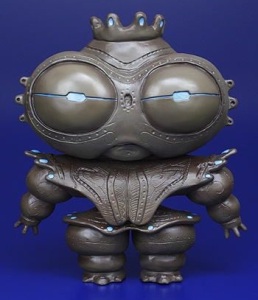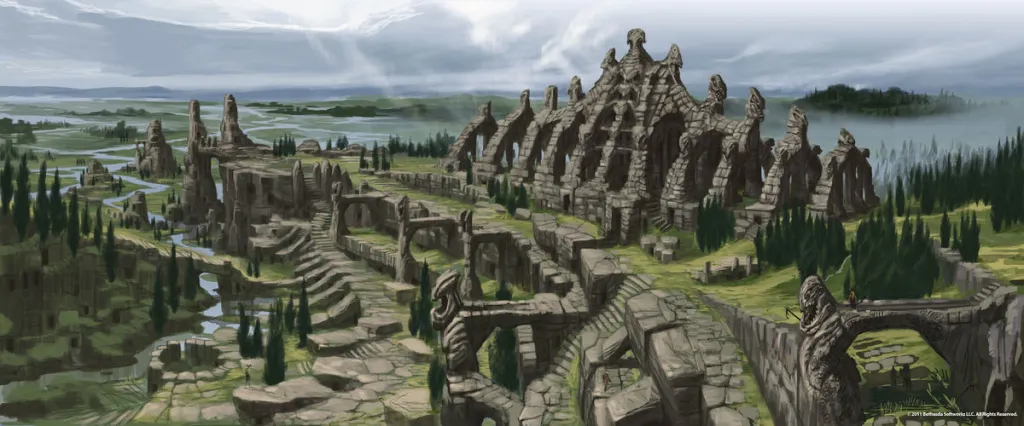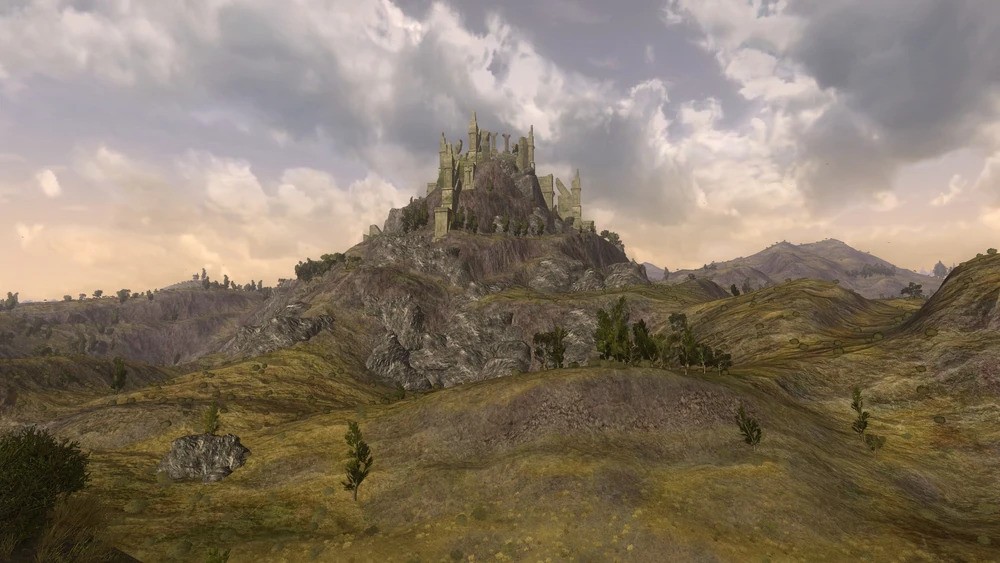Rodrigo B. Salvador
Museum of New Zealand Te Papa Tongarewa. Wellington, New Zealand.
Email: salvador.rodrigo.b (at) gmail (dot) com
https://doi.org/10.5281/zenodo.8352170
As an avid consumer of Japanese video games during my early teens, particularly of the RPG sort, I could not help but notice that some monsters would pop up in several games and typically had a pretty standard depiction. I have always been interested in mythology and could naturally identify the usual chimeras, griffins, phoenixes, and gorgons.
However, these monsters shared their screen time with more unusual ones (or unusual to me at least) from Japanese myths and folklore. Maybe expectedly, I started to read about Japanese myths and to learn about kappa, tengu and many others. Still, one monster, in particular, was suspiciously absent from the books: a sort of statue-like creature with large round eyes (Fig. 1). I did not know its actual name and could not find information about it anywhere.[1]

Then, I forgot all about this monster when I switched my geek focus to tabletop RPGs and my gaming preferences to Western hits (Bioware RPGs, Gears of War, etc.). This lasted until some years ago when I played Persona 4 and Pokémon: Alpha Sapphire for the first time (I had skipped Pokémon’s Gen III back in the day); there and then, I re-encountered that weird statue-like creature (Fig. 2).

Even so, it was not until a recent visit to the British Museum that my interest was reignited. In their Japanese exhibition, I discovered that this creature was not a mythological monster after all — it was nothing like a tengu or a kappa! The damn thing was a prehistoric clay figurine (Fig. 3). As a category, these figurines are called “dogū”.

Needless to say, I began searching for books and scholarly articles about dogū. Sadly, most of the literature on them (and prehistoric Japan in general) is in Japanese, which I cannot read and do not trust Google to translate it for me. Nevertheless, I wanted to report what I could find, just in case these figurines have captured the imagination of someone else out there (maybe someone like you, dear reader). So please keep in mind that my report here is based on the somewhat scarce literature available in English and thus it may lack some information and/or be overly simplified in some aspects.
Before we start, however, I need to briefly explain how Japanese prehistory is divided. So let’s get down to it.
ANCIENT JAPAN
Japanese prehistory can be broadly divided into two large periods: the Paleolithic and what may be informally called “Ancient Japan” (Table 1). The latter is a mixture of the usual Mesolithic, Neolithic and Bronze Age that has defied classification by archaeologists using this standard Western periodization (Imamura, 1996). This span of time contains three periods: the Jōmon, the Yayoi, and the Kofun. Here we are interested only in the first one, the Jōmon period.

Taken literally, Jōmon means “cord-marked”. This refers to the usage of cords to create decorative patterns on ceramics (Fig. 4), which was achieved by simply pressing a cord on the clay prior to firing (Kaner, 2009).

During the Jōmon period, Japan was covered by rich temperate forests (Imamura, 1996). This allowed people to live as hunter-gatherers, although there were phases (maybe seasonal) of sedentism, with some settlements growing quite large and possibly housing a few hundred inhabitants (Imamura, 1996; Henshall, 2004). There is also evidence of slash-and-burn agriculture and limited domestication of plant species, accompanied by skillful management of resources (Imamura, 1996; Habu, 2004). Furthermore, a good portion of the Jōmon people lived close to the coast, exploring marine resources (Henshall, 2004).
The Jōmon period was not, however, a single homogenous thing across all Japan. There was regional variation in habits and material culture, which changed at different paces throughout the country (Henshall, 2004). Furthermore, people from the continent migrated into Japan and added their share of knowledge, culture and genes to the mixture (Imamura, 1996). The Jōmon period ended with the start of rice cultivation and metallurgy.
One important social aspect that gained strength during the Jōmon was how people dealt with the supernatural. Artifacts (Fig. 5), burial practices, and stone circles (Fig. 6) all indicate that religion and ritual were steadily developing throughout the period (Kaner, 2011). One type such artifacts was, of course, the dogū.


PAST DOGŪ
Dogū are ceramic figures produced during the Jōmon period. The earliest dogū dates back to the Incipient Jōmon (Table 2) and they remained restricted in numbers during the Initial and Early Jōmon (Habu, 2004). However, from the Middle Jōmon onwards, their manufacture thrived and their design became more elaborate (Kaner, 2009).

Most of the dogū are clearly female (some of them supposedly pregnant; Fig. 7), so some scholars believe they are representations of an earth-goddess. They claim that this mother-goddess worship is common in agricultural societies, but then again, agriculture was only incipient during the Jōmon period. Other scholars take into consideration the prominence of secondary sex characteristics and hypothesize that the dogū are just general fertility symbols[2], related to fertility rituals and magical protection during dangerous events such as childbirth. This latter option seems apparently more likely, as similar symbols are known from pretty much everywhere.

Nevertheless, considering that figurines such as these have only one function is careless, to say the least (Soffer et al., 2000). As such, other interpretations have appeared in the last decades. For instance, some authors link the increase in the production of dogū from the Middle Jōmon onwards to an increase of agricultural practices and the role of women in this subsistence shift (Togawa, 2003).
The actual functions of dogū remain unknown, but the constant debate makes archaeologists revisit old ideas, propose new ones, and slowly fine-tune our knowledge.
There are several types of dogū, roughly classified by how they look. Because of that, they have some really amusing names (Habu, 2004): heart-shaped dogū (Fig. 8), sitting dogū, mountain-shaped-head dogū, goggle-eyed (or slit-goggle) dogū (Figs. 3, 9), horned-owl dogū.

It is still unclear if these different categories of dogū had distinct purposes or functions. Furthermore, dogū came in several sizes, from palm-sized figurines to large ones more than 30 cm high (Togawa, 2003; Kaner, 2009). As such, it is likely that they had different functions, ranging from personal belongings to probably community-wide ceremonial artifacts (Togawa, 2003).

PRESENT DOGŪ
Today, people can see all sorts of dogū in museum exhibitions around the world, like in the Tokyo National Museum and the British Museum. But they are not merely relics of an ancient past – Japanese people certainly have not forgotten them. For instance, there are some conspicuous monuments in Japan commemorating the most popular type of dogū, the goggle-eyed dogū (or shakōki-dogū).
Two of such monuments can be found in the city of Tsugaru, in Aomori prefecture. The Kamegaoka Site, an archaeological site dating from the Final Jōmon (1,000–300 BCE), is located there. This site is important because it is the place where the most textbook-famous dogū (a goggle-eyed one with a broken leg; Fig. 9) was found back in 1887 (Tsugaru City Board of Education, 2018). One of the monuments is a simple statue (Fig. 10), as could be expected, but the city’s railway station (Fig. 11) is something else entirely!


Box 1. Pseudoarchaeology
Unfortunately, the dogū (especially the goggle-eyed) became victims of human stupidity, just as several other archaeological icons (the pyramids, the Antikythera mechanism, the Nazca lines, etc.). That is, they were linked to alien activity by people who abhor scientific research and methodology and who prefer to make up their own wild stories about reality. Their “explanation” is that the goggle-eyed dogū resembles a person in a space suit. And no, I will not give the reference to their original “works” — these people should not be given the satisfaction of an actual citation!
POP DOGŪ
Given the cultural importance of the dogū in Japan and the increasing influence of television, mangas and video games, it was expected that these clay figures would make their way into pop culture.[3] This is especially true for the fan-favorite type, the goggle-eyed dogū (Rousmaniere, 2009).
The obvious examples, as I mentioned above, come from video games, especially RPGs such as the ever-present Final Fantasy (Square Enix, 1987–present) and Dragon Quest series. The dogū are featured in various games, often just as meaningless enemies in random dungeons. Thus, I will not bore you to death with an extensive list of all dogū appearances. Instead, I will point out just a few examples that I find more meaningful.
One of them is the Pokémon Claydol (Fig. 2), which does not have the most creative name around. It is a Ground / Psychic type and most Pokédex entries on the series point out that it is a clay statue made by ancient people (Bulbapedia, 2018). The entries in Pokémon Sapphire (2002), Black/White 2 (2012) and Alpha Sapphire (2014) date them from 20,000 years ago, which, as we have seen above (Table 1), is a clear exaggeration for the late parts of the Jōmon period.[4] However, the Pokédex entry in Pokémon Ultra Moon (2017) is much more problematic; it reads: “The ancient people who made it apparently modeled it after something that descended from the sky.” Pokémon, of course, is not known for its scientific rigor (Tomotani, 2014; Mendes et al., 2017), but spreading ridiculous alien stories is irresponsible, to say the least (see also Box 1).
Another interesting appearance of the goggle-eyed dogū is in the Shin Megami Tensei series (henceforth SMT; Atlus/Sega, 1987–present), which includes the Persona sub-series. These games allow players to summon mythological monsters (and deities) from virtually all cultures around the world. Since it is a Japanese game, it focuses heavily on Japanese creatures. The goggle-eyed dogū from SMT is called Arahabaki (Fig. 12).

The entries about Arahabaki in the SMT games’ lore describe it as a god (Megami Tensei Wiki, 2018), which we have already established is the less likely hypothesis. The game also refers to it as “he/him” (at least in the English translation), while clearly depicting it with a female body, like the original clay figurines. SMT uses myths as a basis for its setting and story, and infuse them with fiction, so it is hard to tell if their information came from somewhere or if they just made it up to fill a narrative purpose. In any event, their description of the goggle-eyed dogū is off the mark.[5]
Last but not least, there’s Ōkami (Capcom, 2006). The game is set in classical Japan and mixes lots of Japanese myths and folklore. In Ōkami, the goggle-eyed dogū (Fig. 13) is one among many demons that the player faces. The demon’s entry in the game’s bestiary (Okami Wiki, 2018) handles the matter much better than Pokémon: “Of all the odd clay figures in this land, the Dogu is the strangest. Fascinated people have speculated that they originated on the moon.” Thus, the game makes clear that the whole alien thing is just a story made up by some crazy folk.

Dogū are also featured in several mangas (e.g., Doraemon), typically as the focus of one or a handful of chapters. However, one title features them prominently: it is called “Dogū Family” (translation) and was printed in the late 1980’s and early 90’s. The story focused on the everyday life of a family of goggle-eyed dogū in modern Japan. Unfortunately, I could not find the actual manga to read.
Dogū also appear in Japanese products and TV commercials, and there is even one TV show about them: The Ancient Dogoo Girl (“Kodai Shōjo Doguchan”; Fig. 14) and its sequel The Ancient Dogoo Girls (“Kodai Shōjotai Dogūn Faibu”). The series aired on MBS (Mainichi Broadcasting System) from 2009 to 2010.

The series’ plot is very basic Japanese stuff: Makoto, a hikikomori, finds a weird breastplate buried in the woods, touches it, and awakens a girl named Dogu-chan. She is a yōkai hunter from the Jōmon period and ends up living with Makoto. Dogu-chan has a familiar/assistant named Dokigoro (Fig. 15), which is a sentient goggle-eyed dogū that transforms into magical (bikini) armor for its master. The sequel had another five girls wearing armors based on other types of dogū.

The Ancient Dogoo Girl is a very weird and rather embarrassing show, even by Japan standards, as it involves a lot of breasts-based magic. I just skimmed through the first episode to write these paragraphs and already regret it. So if you are curious to watch it, know that you have been warned.
Aliens and bikini armor aside, it is amazing how Japan is always finding ways to keep its culture alive. Because of that, even prehistoric artifacts such as dogū still have a place in modern Japan – and not only a place in museums, as national treasures, but also as pop culture icons.
REFERENCES
Bulbapedia. (2018a) Baltoy. Available from: https://bulbapedia.bulbagarden.net/wiki/Baltoy_(Pok%C3%A9mon) (Date of access: 12/May/ 2018).
Bulbapedia. (2018b) Claydol. Available from: https://bulbapedia.bulbagarden.net/wiki/Claydol_(Pok%C3%A9mon) (Date of access: 12/May/ 2018).
Dragon Quest Wiki. (2018) Pocus poppet. Available from: https://dragon-quest.org/wiki/Pocus_ poppet (Date of access: 16/May/2018).
Habu, J. (2004) Ancient Jomon of Japan. Cambridge University Press, Cambridge.
Henshall, K.G. (2004) A History of Japan: From Stone Age to Superpower. Second Edition. Palgrave Macmillan, Hampshire.
Imamura, K. (1996) Prehistoric Japan: New Perspectives on Insular East Asia. University of Hawaii Press, Honolulu.
Kaner, S. (2009) The Power of Dogu: Ceramic Figures from Ancient Japan. British Museum Press, London.
Kaner, S. (2011) The archaeology of religion and ritual in the prehistoric Japanese archipelago. In: Insoll, T. (Ed.) The Oxford Handbook of the Archaeology of Ritual and Religion. Oxford University Press, Oxford. Pp. 457–469.
Megami Tensei Wiki. (2018) Arahabaki. Available from: http://megamitensei.wikia.com/wiki/ Arahabaki (Date of access: 14/May/2018).
Mendes, A.B.; Guimarães, F.V.; Eirado-Silva, C.B.P.; Silva, E.P. (2017) The ichthyological diversity of Pokémon. Journal of Geek Studies 4(1): 39–67.
Normile, D. (2001) Japanese fraud highlights media-driven research ethic. Science 291(5501): 34–55.
Okami Wiki. (2018) Dogu. Available from: http:// okami.wikia.com/wiki/Dogu (Date of access: 15/ May/2018).
Romey, K.M. (2001). “God’s hands” did the devil’s work. Archaeology 54(1).
Rousmaniere, N.C. (2009) Rediscovering dogū in modern Japan. In: Kaner, S. (Ed.) The Power of Dogu: Ceramic Figures from Ancient Japan. British Museum Press, London. Pp. 71–82.
Salvador, R.B. (2017) Medjed: from Ancient Egypt to Japanese Pop Culture. Journal of Geek Studies 4(2): 10–20.
Soffer, O.; Adovasio, J.M.; Hyland, D.C. (2000) The “Venus” figurines: textiles, basketry, gender, and status in the Upper Paleolithic. Current Anthropology 41(4): 511–537.
Tomotani, B.M. (2014) Robins, robins, robins. Journal of Geek Studies 1(1–2): 13–15.
Tsugaru City Board of Education. (2018) Historic site Kamegaoka Site. Available from: http://jomon-japan.jp/wp-content/uploads/ 2013/07/leaflet_13kamegaoka.pdf (Date of access: 14/May/2018).
ACKNOWLEDGEMENTS
Those figures presented here that were extracted from the Tokyo National Museum (Digital Research Archives: http://webarchives.tnm.jp/) and Wikimedia Commons, have been slightly modified (cropped, etc.) to improve presentation.
ABOUT THE AUTHOR
Dr. Rodrigo Salvador is a paleontologist and biologist, but is irredeemably fascinated with archaeology and mythology. Although his main “thing” remains Ancient Egypt, he is becoming increasingly drawn to the Jōmon and Yayoi periods of Japanese history. He has faced Japanese pre-historic monsters in many JRPGs, sometimes even summoning them to fight on his behalf – well, actually that last bit was just in SMT/Persona, because who on Earth uses a Claydol?
[1] Back then, in my home country, Internet connection was awfully slow and the service very expensive.
[2] The phallic stone rods seen above (Fig. 5) are also typically regarded as fertility symbols (Habu, 2004).
[3] That happened to other weird beings, such as the cartoonish Egyptian god Medjed (Salvador, 2017).
[4] And talking about exaggerating dates, the Japanese archaeologist Shinichi Fujimura claimed to have found Paleolithic artifacts in Japan dating back to 600,000 years ago. However, it was later discovered that he fabricated his own artifacts and planted them on his excavation site so he could “find” them later (Romey, 2001; Normile, 2001).
[5] Arahabaki’s look was very different in early SMT games, such as Megami Tensei II, where it was depicted as a samurai of sorts. So maybe they just retained the name, alongside the original idea/description, and changed this monster’s appearance to that of a dogū in later games.





One response to “Dogū: from prehistoric figurines to collectible pocket monsters”
[…] If you’re interested and want to know more about dogū and their place in Japanese pop culture, I’ve written an article for the Journal of Geek Studies called ‘Dogū: from prehistoric figurines to collectable pocket monsters‘. […]
LikeLike